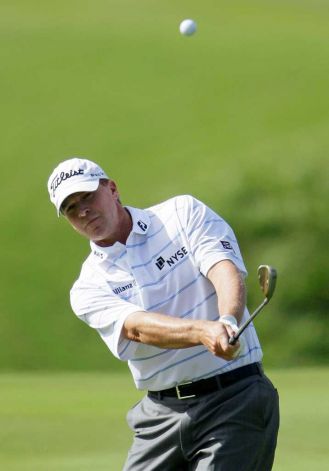The Science Behind Superb Wedges: Part I
/ For years golfers have asked me how to hit low, spinning wedge shots and I've never been able to give them a confident response. After the research I've put in over the past few weeks I can give them a certain answer - and perhaps even explain a few other interesting shots we encounter on the course.
For years golfers have asked me how to hit low, spinning wedge shots and I've never been able to give them a confident response. After the research I've put in over the past few weeks I can give them a certain answer - and perhaps even explain a few other interesting shots we encounter on the course.
In polling better golfers regarding what really good pitch shots look like, the response has almost unanimously been that they tend to be lower with more spin. Edoardo Molinari, the European Ryder Cup golfer and former US Amateur champion was kind enough to help with the research for this article and he stated,
I've watched Tiger, Mickelson and Ernie hit hundreds of 50 yds shots, I've played with them and they all seem to deloft the club without taking much divot.
Which I agree with by the way - the best pitchers always seem to have a knack for nipping the ball off the turf without much divot and then firing the ball in there low and spinning. The problem with this shot has always been how to hit it low, yet make it spin at the same time....
If you hit down on the ball you'll be able to hit it lower, but hitting down more only lowers height and does not, as is commonly believed, make the ball spin more. So that option is out. If we take a more lofted club to spin it more then we may get a little extra spin (although that's not a given), but now the shot will fly too high.
Here is where we need to get a little technical and talk about the forces and angles the club is imparting on the ball at impact. TrackMan uses a term spin loft and it refers to the vertical difference between where the clubhead is travelling at impact (attack angle) and where the clubface is angled at impact (dynamic loft). My research shows that good wedge players have a narrower spin loft (dynamic loft minus attack angle). Let's get a better understanding of these important factors:
Attack Angle (angle that indicates if the clubhead is travelling up or down, relative to the ground at impact)
In studying hundreds of 50 yard pitch shots on TrackMan over the last few weeks I have found that good pitchers tend to not take very large divots. Yes, they always contact the ground, but the club 'bruises' the turf more so than cuts it. This would indicate that the attack angle is shallow - it is down but not hugely so. Now hold on for the following part, because this should not change the way you think about a club striking a ball: my research shows that the attack angle should be shallow enough so that the sole of the club (bounce) actually makes contact with the grass/ground before the ball. And this occurs even on ideal hits.....
Dynamic Loft (the angle of the face/loft at impact)
Really good pitchers have the ability to deloft the club without hitting down more. This means that the hands are in front of the ball at impact and the loft on the clubface is often more than 10 degrees less than the static loft. For example in much of the testing a 54 degree wedge would apply 41-44 degrees of dynamic loft to the ball.
Spin Loft (dynamic loft - attack angle)
This is a very important factor as it contributes to, but does not solely determine, how much spin and loft each shot will have. If you hit a pitch shot with 42 degrees of dynamic loft and you have an attack angle of -3 degrees (the minus indicates a downward hit) your spin loft would be 45 degrees. Common wisdom indicates that a broader spin loft (eg. 50 degrees) would create more spin and height, yet my research indicates that when it comes to chipping and pitching a slightly narrower spin loft (without much downward hit), coupled with clean contact between ball and face increases the golfers ability to hit low spinning wedges. An easy way to narrow your spin loft with pitch shots is to take a lesser lofted club. My students have had tremendous results by using the lob wedge less and getting a little more accustomed to hitting a variety of shots with the pitching wedge.
Friction Launch (the amount of grip between face and ball and how that effects launch conditions)
This type of strike on the ball leads to a scenario where the friction between the face and the ball is far higher than normal. This increased friction leads to a lower launch and trajectory with a substantially higher spin rate. This grip between the ball and face is what I call 'friction launch' and just like the term spin loft it addresses the friction and launch of any shot.
As golfers we've all hit that pitch shot that comes off the face very low and the moment you strike the ball you know it's going to grab as soon as it hits the green. Your playing partners are yelling bite and as soon as the ball gets near the hole it comes to a screeching halt! You have just experienced high friction launch.
Please check back in a few days for the follow up post The Science Behind Superb Wedges: Part II where I'll discuss friction launch in detail and show the results of much of the research I've done.
To get a much better look at the data be sure to read Part II HERE







